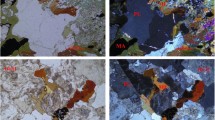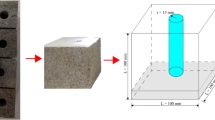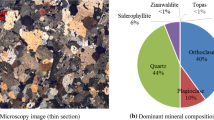Abstract
Pre-existing cracks affect the thermal, hydraulic, and mechanical behavior of rocks. However, little effort has been devoted to investigating thermal cracking interactions with pre-existing cracks. In this paper, we propose a novel thermo-mechanical grain-based finite discrete element method approach to investigate the influence of pre-existing cracks on thermal cracking processes under confining pressure in granitic rocks. An intact synthetic granite sample was mechanically and thermally calibrated against experimental data for Stanstead granite, and petrographic thin sections of thermally treated granite up to 380 °C were used to qualitatively calibrate the thermal cracking pattern in terms of cracking evolution with respect to mineral grains. Then, we introduced varying levels of pre-existing cracks density to the calibrated synthetic sample to study the emergent thermo-mechanical behavior under unconfined and confined conditions. Additionally, we studied the effect of varying friction coefficients of pre-existing cracks on the thermal cracking process. Results show that thermal cracks preferably initiated from the tips of pre-existing ones due to stress concentration and the number of initiated thermal cracks decreased with increasing pre-existing cracks density. A decreasing trend of thermal cracking with confinement was also observed. Interestingly, increasing pre-existing crack friction increased the number of thermal cracks under different confinement conditions due to increased stress concentration along cracks interfaces. The results of this novel numerical process contribute to a better understanding of failure mechanisms in granitic rocks, particularly in geothermal reservoirs and underground nuclear waste repositories under various thermal and mechanical loading conditions.
Article highlights
-
Novel thermo-mechanical grain-based finite discrete element method approach was developed for thermal cracking in granitic rocks.
-
Thermal cracks preferably initiated from the tips of pre-existing ones due to stress concentration.
-
As the pre-existing cracks density increased, the number of thermal cracks decreased, while fragmentation intensity increased.
-
The relationship between isostatic confinement and the quantity of thermal cracks followed a harmonic decay model.















Similar content being viewed by others
Explore related subjects
Discover the latest articles, news and stories from top researchers in related subjects.References
Abdelaziz A, Grasselli G (2018) Investigating frictional behavior of micro-cracks using grain based modelling in the combined finite-discrete element method (FDEM). OnePetro 103:73–81
Abdelaziz A, Grasselli G (2021) Modelling failure in layered geological formations—FDEM: a micro-mechanical approach that bridges across scales. In: Barla M, Di Donna A, Sterpi D (eds) Challenges and innovations in geomechanics. Springer, Cham, pp 140–155
Abdelaziz A, Zhao Q, Grasselli G (2018) Grain based modelling of rocks using the combined finite-discrete element method. Comput Geotech 103(July):73–81
Aboayanah KR, Popoola AK, Sun L, Peterson K, Grasselli G (2021) Grain-based finite-discrete element modeling of thermal cracking in Stanstead granite. In: ARMA/DGS/SEG 2nd international geomechanics symposium, pp ARMA-IGS-21-099
Bauer SJ, Handin J (1983) Thermal expansion and cracking of three confined water-saturated igneous rocks to 800 °C. Rock Mech Rock Eng 16(3):181–198
Brace WF (1965) Some new measurements of linear compressibility of rocks. J Geophys Res 70(2):391–398
Byerlee J (1978) Friction of rocks, rock friction and earthquake prediction. Springer, Berlin, pp 615–626
Cai M, Kaiser PK (2004) Numerical simulation of the Brazilian test and the tensile strength of anisotropic rocks and rocks with pre-existing cracks. Int J Rock Mech Min Sci 41(3):450–451
Chen Y-L, Ni J, Shao W, Azzam R (2012) Experimental study on the influence of temperature on the mechanical properties of granite under uni-axial compression and fatigue loading. Int J Rock Mech Min Sci 56:62–66
Cooper HW, Simmons G (1977) The effect of cracks on the thermal expansion of rocks. Earth Planet Sci Lett 36(3):404–412
David C, Menéndez B, Darot M (1999) Influence of stress-induced and thermal cracking on physical properties and microstructure of La Peyratte granite. Int J Rock Mech Min Sci 36(4):433–448
Durham WB, Abey AE (1981) Thermal conductivity and diffusivity of Climax stock quartz monzonite at high pressure and temperature. Lawrence Livermore National Lab.(LLNL), Livermore
Fortin J, Stanchits S, Vinciguerra S, Guéguen Y (2011) Influence of thermal and mechanical cracks on permeability and elastic wave velocities in a basalt from Mt. Etna volcano subjected to elevated pressure. Tectonophysics 503(1):60–74
Fournier T, Morgan J (2012) Insights to slip behavior on rough faults using discrete element modeling. Geophys Res Lett 39(12)
Fredrich JT, Wong T-F (1986) Micromechanics of thermally induced cracking in three crustal rocks. J Geophys Res Solid Earth 91(B12):12743–12764
Freire-Lista DM, Fort R, Varas-Muriel MJ (2016) Thermal stress-induced microcracking in building granite. Eng Geol 206:83–93
Fu YF, Wong YL, Tang CA, Poon CS (2004) Thermal induced stress and associated cracking in cement-based composite at elevated temperatures––part I: thermal cracking around single inclusion. Cement Concr Compos 26(2):99–111
Fukuda D, Mohammadnejad M, Liu H, Zhang Q, Zhao J, Dehkhoda S, Chan A, Kodama J-I, Fujii Y (2020) Development of a 3D hybrid finite-discrete element simulator based on GPGPU-parallelized computation for modelling rock fracturing under quasi-static and dynamic loading conditions. Rock Mech Rock Eng 53(3):1079–1112
Gao K, Rougier E, Guyer RA, Lei Z, Johnson PA (2019) Simulation of crack induced nonlinear elasticity using the combined finite-discrete element method. Ultrasonics 98:51–61
Geuzaine C, Remacle J-F (2009) Gmsh: A 3-D finite element mesh generator with built-in pre- and post-processing facilities. Int J Numer Methods Eng 79(11):1309–1331
Gratchev I, Kim DH, Yeung CK (2016) Strength of rock-like specimens with pre-existing cracks of different length and width. Rock Mech Rock Eng 49(11):4491–4496
Ha J, Lisjak A, Grasselli G (2015) FDEM modelling of thermo-mechanical wellbore instabilities within shale formations. In: 49th U.S. Rock Mechanics/Geomechanics Symposium. American Rock Mechanics Association, San Francisco, California, pp 10
Hamdi P, Stead D, Elmo D (2015) Characterizing the influence of stress-induced microcracks on the laboratory strength and fracture development in brittle rocks using a finite-discrete element method-micro discrete fracture network FDEM-μDFN approach. J Rock Mech Geotech Eng 7(6):609–625
Heard HC, Page L (1982) Elastic moduli, thermal expansion, and inferred permeability of two granites to 350 °C and 55 megapascals. J Geophys Res Solid Earth 87(B11):9340–9348
Hemingway BS, Krupka KM, Robie RA (1981) Heat capacities of the alkali feldspars between 350 and 1000 K from differential scanning calorimetry, the thermodynamic functions of the alkali feldspars from 298.15 to 1400 K, and the reaction quartz+ jadeite= analbite. Am Mineral 66(11–12):1202–1215
Höfer M, Schilling FR (2002) Heat transfer in quartz, orthoclase, and sanidine at elevated temperature. Phys Chem Miner 29(9):571–584
Hofmeister AM, Carpenter PK (2015) Heat transport of micas. Can Mineral 53(3):557–570
Huang X, Qi S, Zheng B, Liang N, Li L, Xue L, Guo S, Sun X, Tai D (2021) An advanced grain-based model to characterize mechanical behaviors of crystalline rocks with different weathering degrees. Eng Geol 280:105951
Inserra C, Biwa S, Chen Y (2013) Influence of thermal damage on linear and nonlinear acoustic properties of granite. Int J Rock Mech Min Sci 62:96–104
Jansen DP, Carlson SR, Young RP, Hutchins DA (1993) Ultrasonic imaging and acoustic emission monitoring of thermally induced microcracks in Lac du Bonnet granite. J Geophys Res Solid Earth 98(B12):22231–22243
Johnson BG, Handin AF (1979) Thermal cracking of rock subjected to slow, uniform temperature changes. In: Journal Proceedings of the 19th US symposium on rock mechanics, Stateline, Nevada, 1–3 May 1978, V1, P259–267. Publ Reno: University of Nevada, 1978. International Journal of Rock Mechanics and Mining Sciences & Geomechanics Abstracts, 16(2): 23
Johnson B, Gangi AF, Handin J (1978) Thermal cracking of rock subjected to slow, uniform temperature changes. OnePetro
Johnston DH, Toksöz MN (1980) Ultrasonic P and S wave attenuation in dry and saturated rocks under pressure. J Geophys Res Solid Earth 85(B2):925–936
Khaday S, Li K-W, Peng L, Chen C-C (2021) Relationship between friction coefficient and surface roughness of stone and ceramic floors. Coatings 11(10):1254
Knight EE, Rougier E, Lei Z, Euser B, Chau V, Boyce SH, Gao K, Okubo K, Froment M (2020) HOSS: an implementation of the combined finite-discrete element method. Comput Part Mech 7(5):765–787
Kong B, Li Z, Wang E (2018) Fine characterization rock thermal damage by acoustic emission technique. J Geophys Eng 15(1):1–12
Kranz RL (1983) Microcracks in rocks: a review. Tectonophysics 100(1):449–480
Lei Q, Latham J-P, Tsang C-F (2017) The use of discrete fracture networks for modelling coupled geomechanical and hydrological behaviour of fractured rocks. Comput Geotech 85:151–176
Li XF, Li HB, Zhao J (2017) 3D polycrystalline discrete element method (3PDEM) for simulation of crack initiation and propagation in granular rock. Comput Geotech 90:96–112
Li XF, Li HB, Zhao J (2021) Transgranular fracturing of crystalline rocks and its influence on rock strengths: Insights from a grain-scale continuum–discontinuum approach. Comput Methods Appl Mech Eng 373:113462
Li M, Magsipoc E, Abdelaziz A, Ha J, Peterson K, Grasselli G (2022) Mapping fracture complexity of fractured shale in laboratory: three-dimensional reconstruction from serial-section images. Rock Mech Rock Eng 55(5):2937–2948
Lisjak A, Liu Q, Zhao Q, Mahabadi OK, Grasselli G (2013) Numerical simulation of acoustic emission in brittle rocks by two-dimensional finite-discrete element analysis. Geophys J Int 195(1):423–443
Lisjak A, Tatone BSA, Grasselli G, Vietor T (2014) Numerical modelling of the anisotropic mechanical behaviour of Opalinus Clay at the Laboratory-Scale Using FEM/DEM. Rock Mech Rock Eng 47(1):187–206
Lisjak A, Mahabadi OK, He L, Tatone BSA (2020) A fully-coupled, thermo-hydro-mechanical modelling logic for a GPU-accelerated, finite-discrete element method code. In: 54th U.S. rock mechanics/geomechanics symposium. American Rock Mechanics Association, physical event cancelled, pp 16
Mahabadi OK (2012) Investigating the influence of micro-scale heterogeneity and microstructure on the failure and mechanical behaviour of geomaterials. University of Toronto, Toronto
Mahabadi OK, Lisjak A, Munjiza A, Grasselli G (2012) Y-Geo: new combined finite-discrete element numerical code for geomechanical applications. Int J Geomech 12(6):676–688
Mahabadi OK, Tatone BSA, Grasselli G (2014) Influence of microscale heterogeneity and microstructure on the tensile behavior of crystalline rocks. J Geophys Res Solid Earth 119(7):5324–5341
Meng X, Liu W, Meng T (2018) Experimental investigation of thermal cracking and permeability evolution of granite with varying initial damage under high temperature and triaxial compression. Adv Mater Sci Eng 2018:8759740
Nasseri MHB, Schubnel A, Young RP (2007) Coupled evolutions of fracture toughness and elastic wave velocities at high crack density in thermally treated Westerly granite. Int J Rock Mech Min Sci 44(4):601–616
Park CH, Bobet A (2009) Crack coalescence in specimens with open and closed flaws: a comparison. Int J Rock Mech Min Sci 46(5):819–829
Potyondy D (2010) A grain-based model for rock: approaching the true microstructure
Preibisch S, Saalfeld S, Tomancak P (2009) Globally optimal stitching of tiled 3D microscopic image acquisitions. Bioinformatics 25(11):1463–1465
Quey R, Dawson PR, Barbe F (2011) Large-scale 3D random polycrystals for the finite element method: generation, meshing and remeshing. Comput Methods Appl Mech Eng 200(17–20):1729–1745
Ramamurthy T, Arora VK (1994) Strength predictions for jointed rocks in confined and unconfined states. Elsevier, London, pp 9–22
Richet P, Bottinga Y, Denielou L, Petitet JP, Tequi C (1982) Thermodynamic properties of quartz, cristobalite and amorphous SiO2: drop calorimetry measurements between 1000 and 1800 K and a review from 0 to 2000 K. Geochim Cosmochim Acta 46(12):2639–2658
Sagy A, Lyakhovsky V (2019) Stress patterns and failure around rough interlocked fault surface. J Geophys Res Solid Earth 124(7):7138–7154
Shao Z, Sun L, Aboayanah KR, Liu Q, Grasselli G (2022) Investigate the mode I fracture characteristics of granite after heating/-LN2 cooling treatments. Rock Mech Rock Eng 55:4477–4496
Sousa LMO, Suárez del Río LM, Calleja L, Ruiz de Argandoña VG, Rey AR (2005) Influence of microfractures and porosity on the physico-mechanical properties and weathering of ornamental granites. Eng Geol 77(1):153–168
Sprunt E, Brace WF (1974) Some permanent structural changes in rocks due to pressure and temperature. In: Proceedings of the third congress of the international society for rock mechanics, II-A, pp 524–529
Stewart DB, Von Limbach D (1967) Thermal expansion of low and high albite. Am Mineral J Earth Planet Mater 52(3–4):389–413
Sun L, Liu Q, Grasselli G, Tang X (2020a) Simulation of thermal cracking in anisotropic shale formations using the combined finite-discrete element method. Comput Geotech 117:103237
Sun Z, Jiang C, Wang X, Lei Q, Jourde H (2020b) Joint influence of in-situ stress and fracture network geometry on heat transfer in fractured geothermal reservoirs. Int J Heat Mass Transf 149:119216
Tomlinson SE, Lewis R, Carré MJ (2009) The effect of normal force and roughness on friction in human finger contact. Wear 267(5):1311–1318
Tsang C-F, Neretnieks I, Tsang Y (2015) Hydrologic issues associated with nuclear waste repositories. Water Resour Res 51(9):6923–6972
Tse R, Cruden DM (1979) Estimating joint roughness coefficients. Int J Rock Mech Min Sci Geomech Abstracts 16(5):303–307
Van der Molen I, Paterson MS (1979) Experimental deformation of partially-melted granite. Contrib Miner Petrol 70(3):299–318
Wang F, Konietzky H (2019) Thermo-mechanical properties of granite at elevated temperatures and numerical simulation of thermal cracking. Rock Mech Rock Eng 52(10):3737–3755
Wang F, Konietzky H (2022) Thermal cracking in granite during a heating-cooling cycle up to 1000 °C: laboratory testing and real-time simulation. Rock Mech Rock Eng 55:1411–1428
Wang J, Zuo J, Sun Y, Wen J (2021a) The effects of thermal treatments on the fatigue crack growth of Beishan granite: an in situ observation study. Bull Eng Geol Env 80(2):1541–1555
Wang Y, Deng H, Deng Y, Chen K, He J (2021b) Study on crack dynamic evolution and damage-fracture mechanism of rock with pre-existing cracks based on acoustic emission location. J Petrol Sci Eng 201:108420
Wanne TS, Young RP (2008) Bonded-particle modeling of thermally fractured granite. Int J Rock Mech Min Sci 45(5):789–799
Wong T-F, Brace WF (1979) Thermal expansion of rocks: some measurements at high pressure. Tectonophysics 57(2–4):95–117
Yan C, Zheng H (2017) A coupled thermo-mechanical model based on the combined finite-discrete element method for simulating thermal cracking of rock. Int J Rock Mech Min Sci 91:170–178
Yan C, Wang X, Huang D, Wang G (2021) A new 3D continuous-discontinuous heat conduction model and coupled thermomechanical model for simulating the thermal cracking of brittle materials. Int J Solids Struct 229:111123
Yang S-Q (2022) Thermal damage and failure mechanical behavior of granite after exposure to different high temperature treatments under uniaxial compression. In: Yang S-Q (ed) Mechanical behavior and damage fracture mechanism of deep rocks. Springer, Singapore, pp 345–372
Zhao Z (2016) Thermal influence on mechanical properties of granite: a microcracking perspective. Rock Mech Rock Eng 49(3):747–762
Zhao Y, Wan Z, Feng Z, Yang D, Zhang Y, Qu F (2012) Triaxial compression system for rock testing under high temperature and high pressure. Int J Rock Mech Min Sci 52:132–138
Zhao Q, Lisjak A, Mahabadi O, Liu QY, Grasselli G (2014) Numerical simulation of hydraulic fracturing and associated microseismicity using finite-discrete element method. J Rock Mech Geotech Eng 6(6):574–581
Zhao Y, Feng Z, Zhao Y, Wan Z (2017) Experimental investigation on thermal cracking, permeability under HTHP and application for geothermal mining of HDR. Energy 132:305–314
Zhao F, Sun Q, Pan X (2019) Effects of pre-existing fissures on surface macro-crack characteristics of granite subjected to elevated temperatures. Acta Geodyn Geomater 16(4):441–450
Zhou W, Ji X, Ma G, Chen Y (2020) FDEM simulation of rocks with microstructure generated by Voronoi grain-based model with particle growth. Rock Mech Rock Eng 53(4):1909–1921
Zuo J, Heping X, Hongwei Z, Suping P (2010) SEM in situ investigation on thermal cracking behaviour of Pingdingshan sandstone at elevated temperatures. Geophys J Int 181(2):593–603
Acknowledgements
This work was supported by the Natural Sciences and Engineering Research Council of Canada (NSERC) Discovery Grants 341275, PGS D3-518886 and NSERC/Energi Simulation IRC. K. R. Aboayanah acknowledges the funding received from the Lassonde International Graduate Scholarship in Mining at the University of Toronto. A. K. Popoola acknowledges the funding he received from the Queen Elizabeth II Scholarship at the University of Toronto. We would like to acknowledge the contribution of NVIDIA Corporation with the donation of the GPU used for this work. The authors would also like to thank the anonymous reviewers for their constructive comments and suggestions.
Author information
Authors and Affiliations
Contributions
KRA samples preparation, conceptualization, methodology, software, and writing the original draft. AKP samples preparation, thin section analysis and visualization, and writing. AA software, review, and editing. LS conceptualization, software, review, and editing. EO thin section preparation, imaging, and review and editing. KP thin section preparation and analysis, supervision, and review and editing. GG supervision, review and editing, and funding acquisition.
Corresponding author
Ethics declarations
Conflict of interest
The authors declare that they have no known competing financial interests or personal relationships that could have appeared to influence the work reported in this paper.
Additional information
Publisher's Note
Springer Nature remains neutral with regard to jurisdictional claims in published maps and institutional affiliations.
Rights and permissions
About this article
Cite this article
Aboayanah, K.R., Popoola, A.K., Abdelaziz, A. et al. Effect of pre-existing cracks on thermal cracking of granitic rocks under confinement. Geomech. Geophys. Geo-energ. Geo-resour. 8, 126 (2022). https://doi.org/10.1007/s40948-022-00431-0
Received:
Accepted:
Published:
DOI: https://doi.org/10.1007/s40948-022-00431-0




